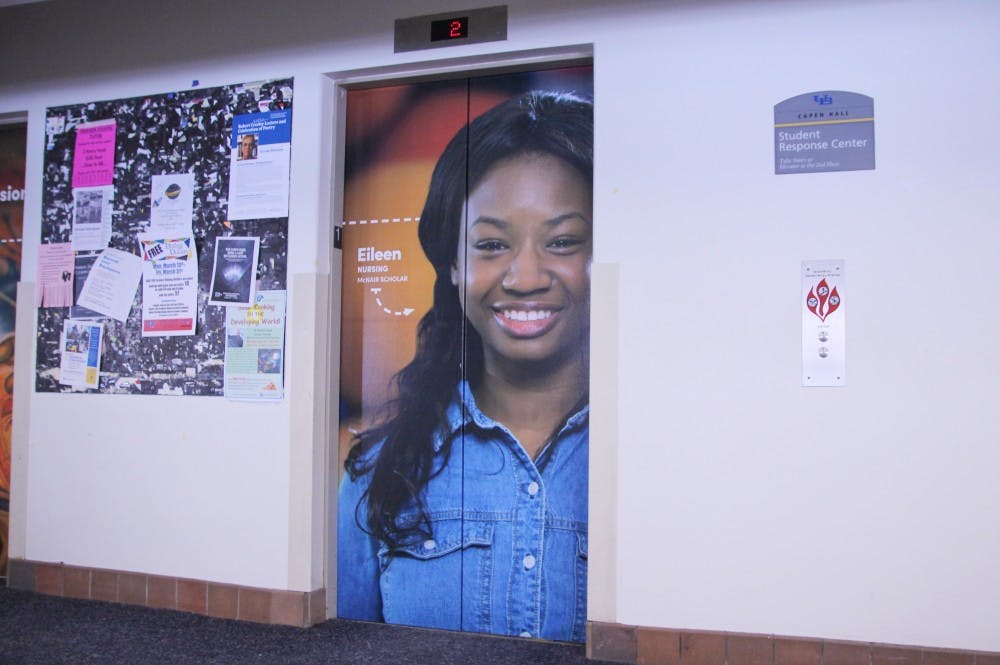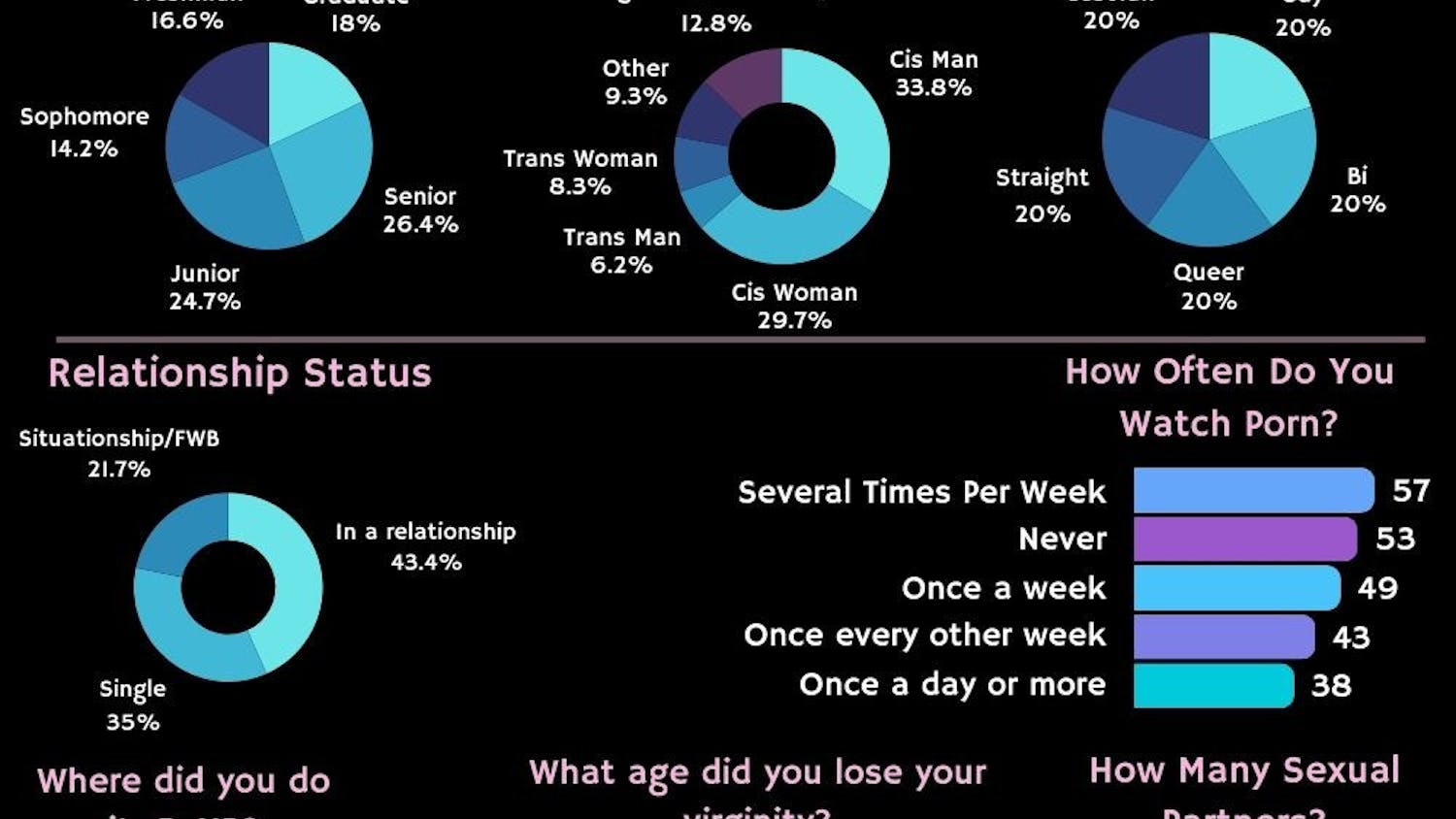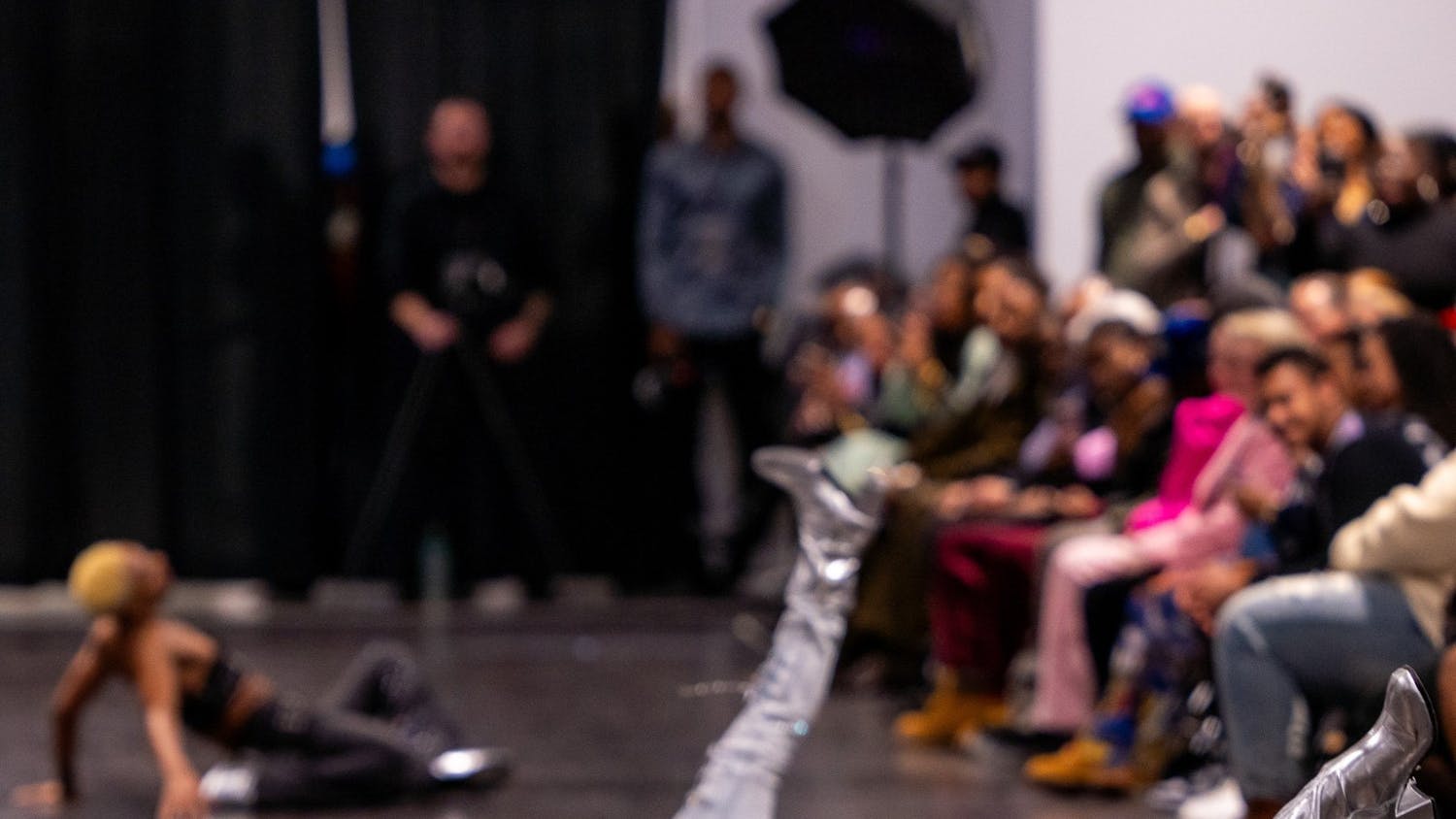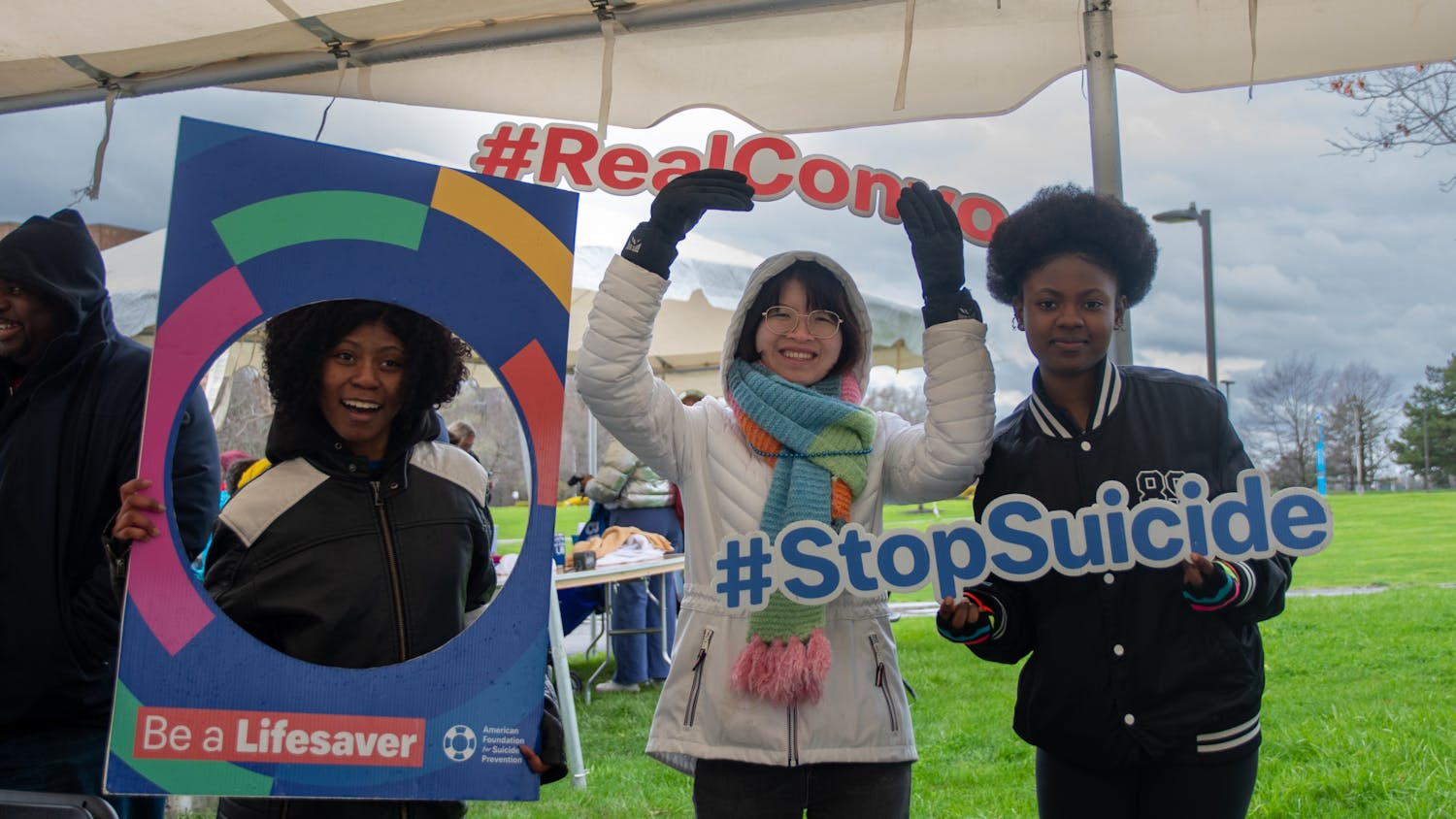Matt Vanderwerf is the UB Stay Longer poster boy, smiling down at UB students from the walkway connecting Clemens Hall and Lockwood Library.
There is just one problem: Vanderwerf dropped out his freshman year.
Angel Cardona’s face graces the cover of the transfer student orientation booklet and transfer students have asked him for advice or about his experiences. He can’t help them because he is not a transfer student.
UB snapped and used his image – along with dozens of other images of students who decorate the campus and advertise for student experiences – without his permission.
It’s all perfectly legal, said Jeffrey Smith, the associate vice president for Marketing and Digital Communications.
UB is a public institution and legally doesn’t have to tell students when pictures snapped on campus will be used for branding and ad campaigns. The university can use whatever image it wants for whatever purpose.
And it does.
Vanderwerf was a UB student long enough for a UB photographer to snap him decked out in UB paraphernalia, including a hoodie and hat, and flanked by two laughing female students. The photo, Vanderwerf says, was taken at the UB orientation.
He transferred to ECC after two weeks on campus.
“It was just too big,” Vanderwerf said. “The class sizes were too big, too many people, it just wasn’t a good fit for me and my learning style.”
The photo appeared as a banner on the walkway well after he left in 2012.
“I actually didn’t know about the banner. A friend sent me a Snapchat that said, ‘Isn’t that you?’ and soon after that all my friends were sending me pictures of my face on the banner,” he said.
Cardona, a junior communication major, said a student recently pointed out his face on the transfer student orientation booklet. The photo was taken during his freshman orientation and he didn’t know his photo was being used.
“This girl said ‘oh I saw you on my transfer student packet!’ and I guess they’ve started spreading out and using my picture for all the orientation books,” Cardona said.
Cardona describes himself as a private person. He doesn’t think the photo used is a flattering image and said he’s selective about which pictures he posts to social media.
“I only release pictures that I choose to release and it really annoys me and makes me uncomfortable because people recognize me more on campus now,” Cardona said. “It’s uncomfortable since [UB] posted without my consent.”
Cardona feels that the university has violated his personal preferences.
But Cardona and Vanderwerf aren’t the only students whose photos have been published without permission.
Take Eileen Diih. She graduated as a nursing major in May, but a life-sizedphoto of her still fills the elevator doors of Capen Hall. Her face literally splits open every time the doors open.
“I was not told my picture was going to be used on an elevator,” she said. “I was actually doing a photoshoot for the UB Undergraduate Viewbook,” Diih said.
Diih said her image has attracted a lot of attention and she feels weird about the way people are talking about her.
“It was a total surprise, I started receiving a bunch of snaps on Snapchat, emails from professors and Facebook posts of my friends taking a picture with my face splitting in two,” Diih said.
Although UB does not have to tell students it will use their images on banners, elevators, bus stops, dining hall walls and brochures, many students feel UB representatives should call them out of courtesy. Smith disagreed and said no one has ever complained or issued a formal complaint about the practice. On the contrary, he said, most students say they are pleased to have a moment of college campus fame.
Caleb Vaughn, a business major and 2015 graduate, who served as an orientation leader in 2013, was shocked to see his face adorning the 2013-14 student planner. The university gives the planner to 4,000-5,000 freshmen and any other interested students in the first weeks of school.
The university sent an email saying orientation images might be used, but no one ever told him his image had been selected.
After he saw the images, Vaughn was angry. In summer 2013, he wrote a series of outraged comments on social media insisting UB should have paid him for his photos.
He’s calmer now.
“I think at the end of the day it’s cool to have my image on things,” Vaughn said. “Now it doesn't anger me to be featured on all these posters and planners. I just think getting a notification should be given, but it's not a huge deal. I wonder how long after my graduation the pictures will continue to be used.”
The faces of UB
“As new faces appear on campus every year, the UB photo database is continuously updated,” Smith said. He added that his office cares more about the message the image evokes than the status of the student featured.
Vaughn recognizes that UB is an international school with lots of different cultures, but he did feel like he was being targeted – because he is a minority – to market the school’s message.
“I do think that the school’s marketing gives somewhat of a false advertisement to prospective students,” Vaughn said. “People see that the school is hugely diverse as a lot of these images of students are of minority backgrounds but UB has a student population of mostly white students.”
Vaughn’s sister is on the cover of this year’s student planner. Just like Vaughn, his sister’s photo was taken during orientation and she had no idea the photo would be used.
“There are no rules or regulations that require UB to alert students if their picture is being taken, or if it will be used for any future advertising,” Smith said. “We don’t typically notify students when their picture will be used, but in many instances, students are the featured part of the use (e.g. a profile on that student) in which case they are fully aware that they will be photographed and their photo[s] will be used.”
This is what happened to current SA president and senior business and musical theater major, Matt Rivera. His face opens and closes on a Capen elevator as a part of UB’s new rebranding campaign, which also promotes double majoring at UB.
“I allowed my picture to be featured on the elevator because I was asked,” Rivera said. “It wasn’t a paid gig. The university was using a wide array of students from many disciplines and backgrounds to help represent the true nature of the student body – an effort that I highly commend UB for reaching towards.”
The response has been mainly positive for Rivera and students who see the poster as they pass through Capen every day.
“My friends usually send me a picture or a Snapchat of my face. I have had people send me videos pretending to talk to me, pretending to feed me and many more creative things,” Rivera said. “People also askabout my dual degree, too. A professor reached out to ask me questions about doing two very separate programs and what the experience has been like.”
Rivera said he believes his picture will be removed after he graduates in May, but that may not be the case. Despite the fact that Diih graduated last spring, her photo is still displayed on the elevator.
Capturing diversity
Unlike other New York State public schools, UB doesn’t require students to fill out a photo waiver allowing the school to use their pictures.
If a student has been photographed but doesn’t wish to let the school use a picture, or does not want to be photographed at all, the student can get an exemption from UB’s Student Affairs office.
“The office advises that photographs of university events and members of the campus community are regularly taken and subsequently displayed depicting the vitality of UB,” Smith said. “If you do not want your picture used in this manner, please advise the photographer.”
Most UB websites host slideshows of smiling students of mixed ethnicities and highlight the university’s diversity. Approximately 48 percent of UB students are white, 7 percent are black, 6 percent are Hispanic, 14 percent are Asian, 17 percent are international and 8 percent are “other,” according to UB’s 2015 demographic statistics.
Douglas Levere, the university’s photographer, declined to comment on the photos he shoots for UB. However, Jeffery Smith, his boss, reassured The Spectrum that Levere attends many events on campus and attempts to accurately portray university life.
“[Levere] shoots a myriad of events and an integral part of his shooting is to capture an authentic snap-shot of campus life, showing the breadth of activities the university has to offer and the diversity of our student body,” Smith said.
While UB has never received a complaint about taking a student’s picture, other schools have encountered issues with trying to play up the school’s diversity through photos.
Ken Chamberlain, a photographer for Ohio State University (OSU), said he and OSU follow similar guidelines to UB’s, but he has received some backlash for his attempts to highlight the school’s diversity.
In his 10 years of working for the school, Chamberlain has only had one student complain about a photo he’d taken.
“She was a student from Egypt, she was Muslim wearing her hajib and I took a picture of her at a school event,” he said. “She complained because she thought I was taking a picture of the token Muslim student to show the school’s diversity. Besides her, usually students are happy to have their picture taken.”
Similar to UB, there is no photo waiver form that OSU students need to fill out. Once matriculated, students give the school the right to take pictures of them.
“The campus is public property and we can take pictures of whoever and whatever we want,” Chamberlain said.
Marketing moments
Indranil Goswami, an assistant professor in the marketing department, explained that given the large student body, the university probably had no idea about the backstory of each student they photograph.
“It’s a public space and if the students know they’re being photographed and as a result of being at a UB event they are probably implicitly giving the university permission to use their picture,” Goswami said. “When organizations invest money in certain events they would also like to promote those events, so they take pictures.”
Smith defended UB’s policies and emphasized that UB rarely uses stock images and only relies on them as a last resort.
“When we need to illustrate an abstract concept, or perhaps a message that depicts a sensitive situation (e.g. mental health services) we’ll use stock images,” Smith said. “Those are the only cases where it wouldn’t be appropriate to use a photo or composition of an actual UB student.”
Goswami believes Student Affairs could market its office better and let students know they have an option to change their photo preferences.
“As a principle, as long as the particular person is aware of this type of interaction, I think it’s fine. I think it should probably be said in some type of student brochure that there’s an option to voice your concerns with the university using your picture.” Goswami said.
Although Levere is UB’s main photographer, the university occasionally hires freelance photographers and companies to illustrate graphics or assist in additional photography, Smith said.
Laura Sargent, owner of 12 Grain Studio in Lockport, works closely with UB and provides the university with graphic illustrations for marketing campaigns.
Sargent’s company has been providing UB with graphics for over two and a half years. She said illustrations are usually charts or informational facts next to a student’s face.
But not all students are comfortable with their faces being used for marketing.
Cardona, the student whose face is on the transfer student orientation booklet, said if the university had asked him to use his photo, he would have declined. He didn’t ask for the photo to be removed because it was already in use.
“Everyone sees themselves differently and everyone knows what they want themselves to look like. This is a public space so they’re entitled to take students’ pictures, but I don’t think that our identity should be used without our consent,” Cardona said. “I know it’s hard with so many students and in many cases, they don’t know who the pictured student is, but it’d be nice if we were asked first.”
Max Kalnitz is the senior arts editor and can be reached at max.kalnitz@ubspectrum.com





